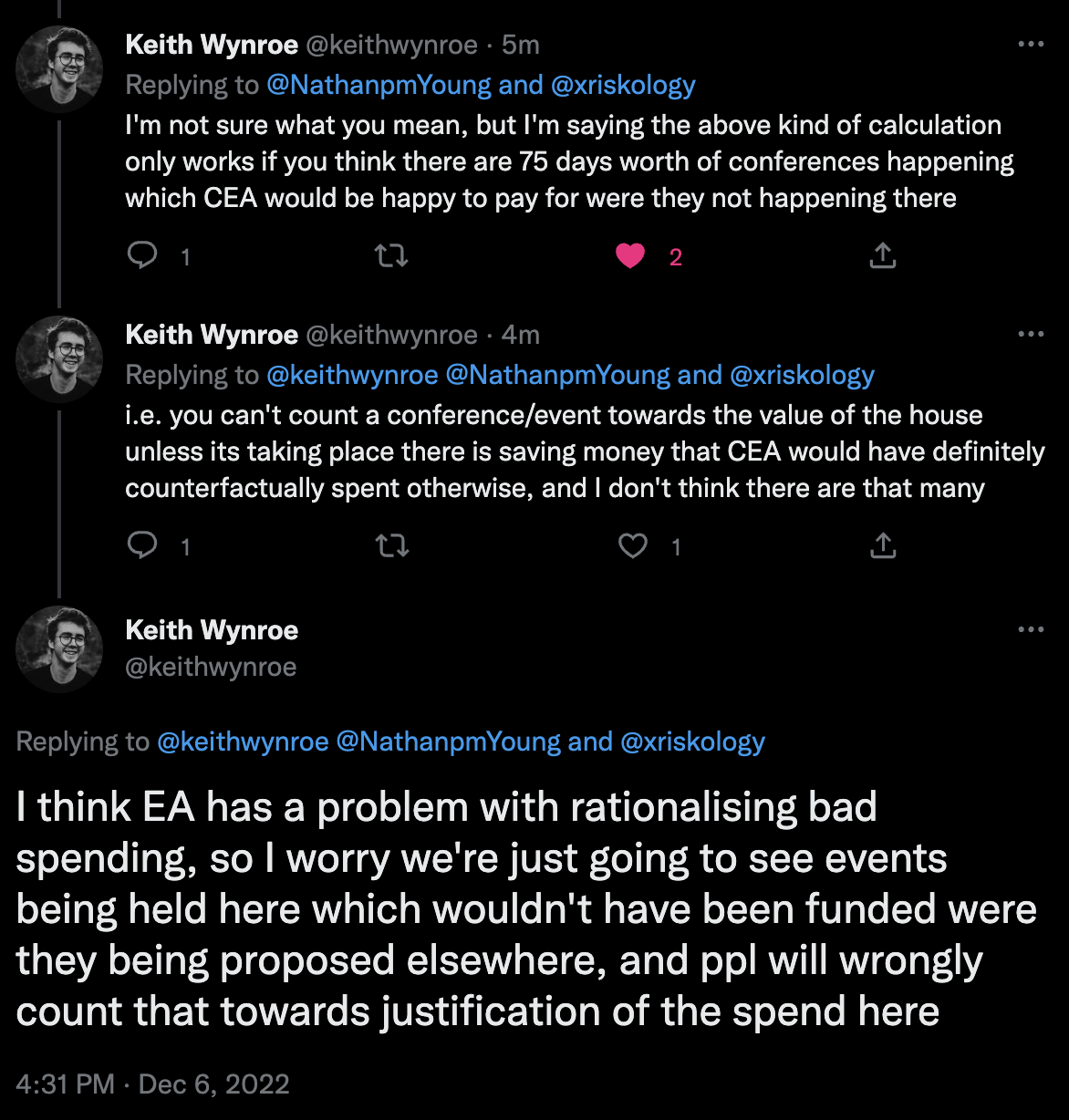Edit to add (9/1/2023): This post was written quickly and I judged things prematurely. I also regret not reaching out to Effective Ventures before posting it. Regarding my current opinion on the Abbey: I don't have anything really useful to say that isn't mentioned by others. The goal of this post was to ask a question and gather information, mostly because I was very surprised. I don't have a strong opinion on the purchase anymore and the ones I have are with high uncertainty. More thoughts in my case for transparent spending.
Yesterday morning I woke up and saw this tweet by Émile Torres: https://twitter.com/xriskology/status/1599511179738505216
I was shocked, angry and upset at first. Especially since it appears that the estate was for sale last year for 15 million pounds: https://twitter.com/RhiannonDauster/status/1599539148565934086
I'm not a big fan of Émile's writing and how they often misrepresent the EA movement. But that's not what this question is about, because they do raise a good point here: Why did CEA buy this property? My trust in CEA has been a bit shaky lately, and this doesn't help.
Apparently it was already mentioned in the New Yorker piece: https://www.newyorker.com/magazine/2022/08/15/the-reluctant-prophet-of-effective-altruism#:~:text=Last year%2C the Centre for Effective Altruism bought Wytham Abbey%2C a palatial estate near Oxford%2C built in 1480. Money%2C which no longer seemed an object%2C was increasingly being reinvested in the community itself.
"Last year, the Centre for Effective Altruism bought Wytham Abbey, a palatial estate near Oxford, built in 1480. Money, which no longer seemed an object, was increasingly being reinvested in the community itself."
For some reason I glanced over it at the time, or I just didn't realize the seriousness of it.
Upon more research, I came across this comment by Shakeel Hashim: "In April, Effective Ventures purchased Wytham Abbey and some land around it (but <1% of the 2,500 acre estate you're suggesting). Wytham is in the process of being established as a convening centre to run workshops and meetings that bring together people to think seriously about how to address important problems in the world. The vision is modelled on traditional specialist conference centres, e.g. Oberwolfach, The Rockefeller Foundation Bellagio Center or the Brocher Foundation.
The purchase was made from a large grant made specifically for this. There was no money from FTX or affiliated individuals or organizations." https://forum.effectivealtruism.org/posts/Et7oPMu6czhEd8ExW/why-you-re-not-hearing-as-much-from-ea-orgs-as-you-d-like?commentId=uRDZKw24mYe2NP4eq
I'm very relieved to hear money from individual donors wasn't used. And the <1% suggests 15 million pounds perhaps wasn't spent. Still, I'd love to hear and understand more about this project and why CEA thinks it's cost-effective. What is the EV calculation behind it?
Like the New Yorker piece points out, with more funding there has been a lot of spending within the movement itself. And that's fine, great even. This way more outreach can be done and the movement can grow. But we don't want to be too self-serving, and I'm scared too much of this thinking will lead to rationalizing lavish expenses (and I'm afraid this is already happening). There needs to be more transparency behind big expenses.
Edit to add: If this expense has been made a while back, why not announce it then?


Thanks for the insightful comment, Jack. I should have been clearer that "is it waivable" has both a procedural and a substantive component -- a non-conflicted organizational authority needs to determine that waiver is in the best interests of the organization. And it's certainly reasonable for people to think that it would have been preferable for OP to take a different approach.
But on the known facts, I conclude that a decision to waive would be reasonable on the best-interests standard: Claire had no personal interest in the grant outcome, and is basically on EVF's board at OP's request as its representative-of-sorts (rather than her happening to be on the board of a grant-seeking organization for her personal reasons). I still think there is a COI there, but I would rate it as fairly mild when viewed through the eyes of an observer with knowledge of all relevant facts.
I don't think the alternative of having someone else do the grant investigation actually achieves the same benefit to OP. If you think Claire has a COI and needs to recuse, then she needs to be walled off from OP's evaluation of this grant altogether. But that defeats OP's presumed purpose of having Claire on EVF's board in the first place -- to be able to use the information and experience she obtained in evaluating grant proposals instead of relying more heavily on EVF's submissions. If OP thinks that is an important advantage, having the grant investigator on EVF's board seems to be the only way to get it. I guess you could have a different grant investigator with Claire merely providing input in some fashion . . . but in my book, that's just getting some of the potential benefit while accepting some of the COI. I think that's an important distinction from your OFTW hypothetical -- in that hypothetical, there were likely other vendors from whom the organization could have purchased the same services from.
Finally, there are some other background facts that make me apply a more deferential standard of review to OP's waiver decision here:
I think you are absolutely right to be vigilant about COI issues, and I would probably agree with your position if some of these facts were different. I'm just not concerned by this one on these facts.